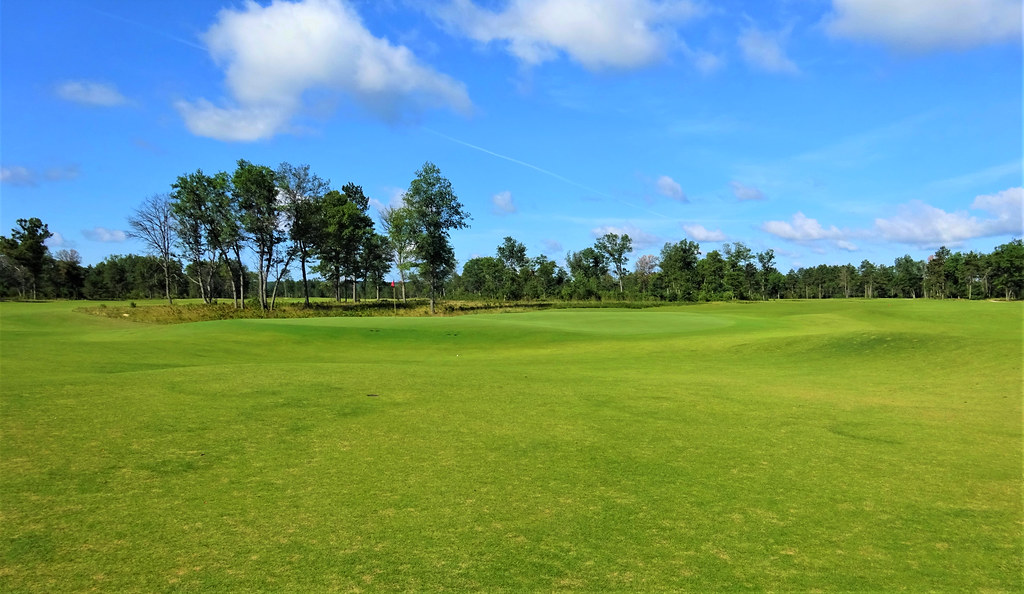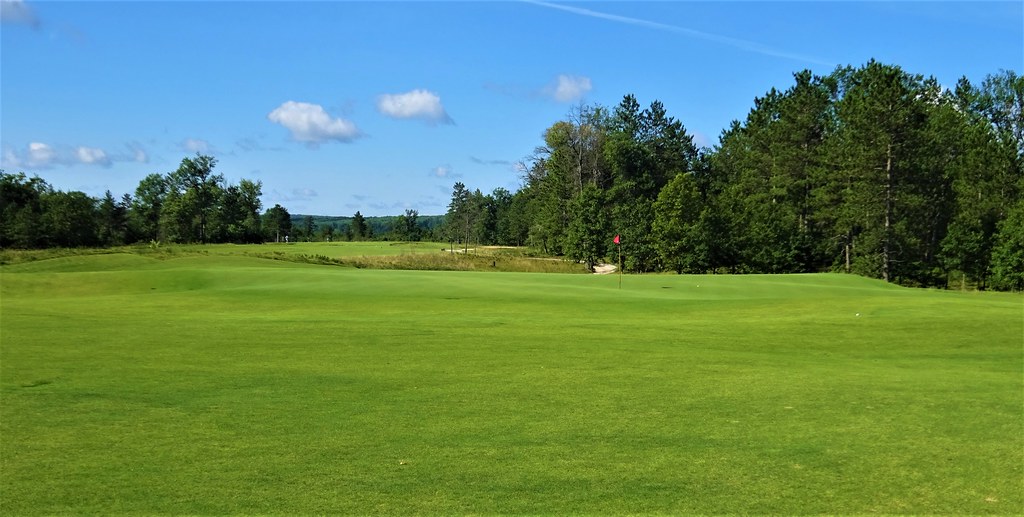The Loop was virtually a life-long ambition of Tom Doak. Since reading about Tom Simpsonís idea for a short reversable course some 40 years ago in The Architectural Side of Golf, Doak waited for the right land and the right owner. Due to its flat, open site, there was an opportunity to create such a course for Texas Tech University. However, there was concern about the visual aspect of the design so the idea wasnít pursued. Jump ten years into the future and at the other end of the country, another opportunity arose. The owner of Forest Dunes, Lew Thompson, approached Doak to design a second course for the resort which he had recently acquired. The new course had to achieve the two goals of encouraging golfers to stay on site and wow them. While the land is sandy and perfect for golf, it isnít a site that will captivate golfers. The wow factor would have to come from the design rather than the location.
Several elements combined to make this site a good candidate for a reversible course. The property is sandy which made construction relatively simple. There were large areas of land already cleared of trees. There were virtually no beautiful specimen trees which needed protection. There were no dramatic elevation changes which would create blind shots. Lew Thompson may have been the perfect owner to green-light such an idea because he wasnít a golfer with the baggage of preconceived notions which needed to be placated. The elements were in place for Doak to fulfil a lifelong dream. Doak also understood that a reversable course must deliver two loops of approximately equal quality for the idea to survive. With that in mind he worked on the Black Course second to fit with the Red Course. This would help mitigate a large disparity in quality between the loops which would surely see the ruthless business end of the decision-making process put an end to the experiment. Surprisingly, to me anyway, it only took about a month for Doak to devise a routingÖ.yes, a month.
When meeting with L Thompson Doak showed the plans for the Red Course which would play counter-clockwise. After allowing for some comments, Doak then revealed the plan for the other course, a clockwise course? It wasnít a separate 18 design, but an 18 green and fairway reversable 18-hole course. Two courses in one which when combined with Tom Weiskopfís Forest Dunes would give golfers reason to possibly spend two nights on site. The added amount of acreage and short grass necessary for a reversible course would jack the maintenance costs up somewhat, but Thompson immediately grasped the concept and must have thought the idea would provide the wow factor and put bodies in beds. Work began the following year and The Loop was opened in 2016.
Before playing I was concerned about the courses melding together as one. A few issues perplexed me. For instance, there canít be too many bunkers on a reversable course before things start to unravel. How then to create added drama on a subtle property? Well, that isnít a problem because Doak made a career of creating interest from the green back to the tee and use of short grass. I didnít see it happen, but itís quite possible to go many 10s of yards long on some approaches. That isnít something one sees every day. Somewhat similar to Pinehurst 2, many of the greens are pushed up/crowned which emphasizes good approach angles and missing in recoverable spots. The bottom line is the bunkering is important, but not in a way which dominates the design.
A second apprehensiveness I had was how would the unused teeing areas blend into the design? The answer is rather simpleÖonce I saw it in action. The teeing areas are kind of half built and often more rounded. When using the tees, they are obviously tees. When not in play they blend into the surrounding area. Without the creative single flags indicating the tee positions one has to pay attention as to where the opposite course tees are. Itís a slick solution that on some level took some thinking outside the box. Related to tees are the mounding etc for the greens. The integrated shaping to make these features part of the hole from any angle must have been an unusual assignment. The flow of this work with the overall aesthetic is marvelous. The shaping to conceal some of the more aggressive crowned nature of the greens is a bit of razzle dazzle.
A final worry of mine was carts. The Loop was lucky in that the course was designed not to use carts. However, carts are most certainly and regretfully on display far too much. A counter-measure is the carts are programmed to restrict their use. At least there arenít dreadful cart paths cutting through the course which would diminish the aesthetic moreso than the ďcart tracksĒ easily seen on short grass. Letís hope cart paths are never built, although I wonder if open hard sandy areas in pinch points etc may help disguise the minor damage.
After spending the night in one of the excellent lodges we made tracks to the Red Course (counter-clockwise). The opener is less welcoming than on the Black. The drive is semi-blind over a native area to a low lying section of the fairway shy of a few bunkers. After playing the hole I wondered if it may not be better to lay back off the tee for a better view of the tricky, sloping left green. The photo below is about 175 yards out after a lay-up.

An excellent par 5, the second features a much talked about green with the the large dip in the middle. On this hole the dip faces the fairway and isn't a bad line of approach for a long running second shot. However, a small mound is on this line and can shove a shot either left or right. The drive too is interesting for guys who can't hit the ball very far. There is a small bunker pinching the left side online with the green which is about 400 yards to carry in two. Below is the view of a typical second shot.

The fiesty mound and green.

Another shot with native encroaching the line of play. #3 tee shot is fairly narrow.

The open front green is a beauty.

The next tee is a fair walk to an area which feels like the middle of a fairway. Well it is, the fairway for another short hole, 15 Black. The plateau green feeds left to trouble over the rear. This is an excellent example of an understated hole of high quality.

More to follow.
Ciao